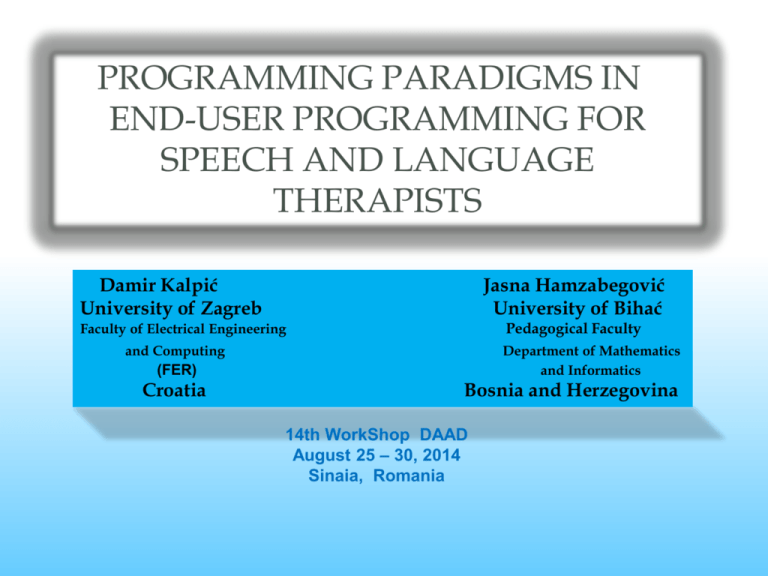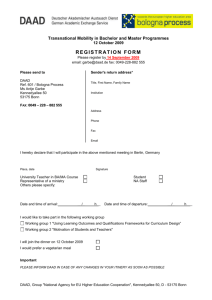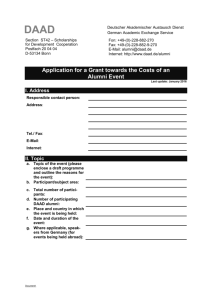Programming paradigms
advertisement

PROGRAMMING PARADIGMS IN END-USER PROGRAMMING FOR SPEECH AND LANGUAGE THERAPISTS Damir Kalpić University of Zagreb Jasna Hamzabegović University of Bihać Pedagogical Faculty Faculty of Electrical Engineering and Computing Department of Mathematics and Informatics (FER) Croatia Bosnia and Herzegovina 14th WorkShop DAAD August 25 – 30, 2014 Sinaia, Romania Presentation Overview OVERVIEW INTRODUCTION • The End–User (EU) / The End-User Programmer (EUP) • The Speech and Language Therapist (SLT) IDENTIFIED ISSUES PROGRAMMING PARADIGMS DEVELOPMENT ENVIRONMENT • Visual Development Environment for Component Software Development CONCLUSION 14th WorkShop DAAD Sinaia, August 25-30, 2014 Introduction THE END–USER (EU) The person who uses an item of commerce for its designed purpose* (JOB) The person who uses a computer application, as opposed to those who developed or support it. * *WEBSTER DICTIONARY (http://www.webster-dictionary.org/definition/end-user) THE END–USER PROGRAMMER (EUP) The person who writes programs to support some goal in his own domains of expertise (secretaries, accountants, children [Petre and Blackwell 2007], teachers [Wiedenbeck 2005], interaction designers [Myers et al. 2008], scientists [Segal 2007] )** **A.J. Ko et al.: "The State of the Art in End-User Software Engineering", ACM Computing Surveys, Vol.43, No.3, 2011, pp. 1-44 (http://web.media.mit.edu/~lieber/Publications/End-User-Software-Engineering.pdf) THE SPEECH AND LANGUAGE THERAPIST (SLT) The person who works closely with infants, children and adults who have various levels of speech, language and communication problems * The specialist who deals with the correction of the speech sounds, the disorders in writing (Dysgraphia), reading (Dyslexia) and mathematical operations (Dyscalculia). * (http://www.prospects.ac.uk/speech_and_language_therapist_job_description.htm) TODAY THE SPEECH AND LANGUAGE THERAPIST IS ONLY END-USER Identified Issues End-User Development Prof.Mary Shaw, Carnegie Mellon University The 7th joint meeting of the European Software Engineering Conference (ESEC) , 2009 In 2012 US Bureau of Census and Bureau of Labor In 2005 100000000 90000000 90 mil 80000000 70000000 60000000 50 mil 50000000 40000000 30000000 20000000 10000000 12 mil 3% 3 mil 0 End-Users Users of Spreadsheets and Databases Persons who were programming on their jobs 14th WorkShop DAAD Sinaia, August 25-30, 2014 Professional Programmers Identified Issues SCIENTIFIC ISSUES AND OBJECTIVES What are the main hindrances in development of computer applications by the end-users? How the non-programmers naturally perceive the programming? Which approaches for application development are feasible for non-programmers? The development framework and software tools for speech therapists? The relevant areas: Software Engineering End User Development Psychology of Programming Programming Paradigms Software Engineering : The advantages of three paradigms : Component Based Software Development, Visual Programming, Event-Driven Programming. The components should map concrete artifacts from the therapists practice: 14th WorkShop DAAD Sinaia, August 25-30, 2014 Programming Paradigms Software Engineering : Paradigms: Component-Based Software Development, Visual Programming, Event-Driven Programming. The components shall be visually intuitive to enable visual composition of future application. Event-driven programming shall enable the software engineers to animate the visual components. 14th WorkShop DAAD Sinaia, August 25-30, 2014 Visual Development Environment for Component Software Development The framework and a visual language for therapists: The WYSIWYG editor to simplify the visual design and user-interface building. The components: intuitive and meaningful units, minimally interdependent, useful, reliable, interoperable, ... Construction of applications is visualised and debugging and testing are interactive. Ribbon Bar Scene 14th WorkShop DAAD Sinaia, August 25-30, 2014 Workspace Visual Development Environment for Component Software Development Development Environment for Speech and Language Therapists (DESLT) Visual Development Environment for Component Software Development From the Therapist’s Point of View The user interface offers a window with multiple design plates. Setting Properties of Objects Instantiation Objects Scene Workspace Programming 14th WorkShop DAAD Sinaia, August 25-30, 2014 Visual Development Environment for Component Software Development From the Therapist’s Point of View The procedure of instantiation of a component Visual Development Environment for Component Software Development From the Therapist’s Point of View The result of instantiation of a component by defining the parameters: Adjusting the component properties, behaviour and actions: Drag&drop component: 14th WorkShop DAAD Sinaia, August 25-30, 2014 Testing of the component: Visual Development Environment for Component Software Development From the Therapist’s Point of View DESLT is an intuitive and powerful WYSIWYG environment. This one is aimed exclusively at development of therapeutic applications for therapists. For treatment of dyslexia, components have been created and situated in the toolbar: At any moment, therapist-programmer can run the application by clicking on the button RUN. The completed application shall be distributed to the patients as a standalone EXE file. 14th WorkShop DAAD Sinaia, August 25-30, 2014 Visual Development Environment for Component Software Development From a software engineer’s point of view: The software component is an independent object bearing its function. It is an independent executable unit. The source code need not be available to therapist-programmer and it shall not be compiled with other parts of the future application program. It publishes its interface and all the related operations are performed through that interface. The internal component state is not visible. To build a prototype of the future development framework DESLT, it was used: MS Visual Studio 2012 where in programming language C# the functionalities have been implemented, MS Expression Blend 4 to create the environment interface that generated a corresponding XAML code. 14th WorkShop DAAD Sinaia, August 25-30, 2014 Visual Development Environment for Component Software Development From a software engineer’s point of view: The Class Diagram of the component WWPT&S 14th WorkShop DAAD Sinaia, August 25-30, 2014 Visual Development Environment for Component Software Development From a speech therapist and software engineer’s point of view: The rule: When the property of the Text component Queue is equal The plate for rules definition The list of predefined actions: Rotate, Unhide, Hide, StartSound, to the property Text of the component WWPT&S, rotate the component WWPT&S. CONCLUSION : Component based software development is a paradigm for development of applications, implementing and combining the existing off-the-shelf components. Quick and simple development of application programs will rely on available libraries of readymade components. While involving only a small number of software engineers, the new components could be designed and distributed over the WWW. The model could support run-time functional queries, enabling to therapist the Web search in order to retrieve the desired components. The therapist should be able to download and install them in his or her framework, with a single mouse click. The quick Web transfer can be expected. The downloaded component shall be self-installable. 14th WorkShop DAAD Sinaia, August 25-30, 2014 CONCLUSION : The application programs to help in dyslexia treatment should have the features of the modern windows desktop applications, of Web applications and mobile applications. Development framework can be built in MS WPF technology. After having been educated to use the development framework, the therapists may use their primary competence to design the therapeutic applications. Empowering of therapists as end-users in development of proprietary application programs, may initiate and support the professionals in other areas to become creators of software to fulfil their own needs. Current programming paradigms make it possible! 14th WorkShop DAAD Sinaia, August 25-30, 2014




